RetroLisa
--------- | 1990s Products &
Technology | |
|
___________________________________________________________________________________________________________
|
|
|
RetroLisa
| ___________________________________________________________________ | __ | _____________________________ | _______ | Communication

cell phones
Mobile phone technology was developed in the 1940s. Because of the large battery requirement, most early phones were installed in cars. Calls were handled by base stations with antennas, and once you were out of range, you were out of luck.
In cellular technology, each base area is known as a cell. The calls are relayed by cell towers, which have the ability to seamlessly transfer calls to neighboring cells if the caller moves out of range. This technology, along with smaller and more efficient batteries, was developed by Motorola and Bell Labs in the 1970s. After a period of testing, the first cell phone network in America went live in 1983. It used the DynaTAC, Motorola's first portable handheld cell phone, which was affectionately known as the brick.
In the early 1990s, handheld phones were still quite large and very expensive. Car phones, suitcase phones, transportable phones and bag phones were cheaper and far more common. A transportable phone resembled a car battery with a handset mounted on top. It could be installed in a car, carried by the handle or slung over the shoulder. A bag phone consisted of a handset, machinery and battery enclosed in a leather zipper case. The first bag phones were introduced in 1990.
Having a cell phone antenna mounted on the roof of your car became a status symbol. If you couldn't afford a car phone, fake antennas were available to give your car that look of luxury.
In the mid 1990s, the size and cost of a handheld phone finally became small enough to make them affordable for the general public. At this point, cell phone ownership increased dramatically. In 1992, just 4 percent of the American public were cell phone subscribers. This figure increased to 18 percent in 1997, and to 32 percent in 1999.
Vintage Mobile Phones
Motorola Bag Phones
Analogue Mobiles
text messaging
The cell phone industry adopted digital technology in the 1990s. This made the Short Messaging Service (SMS) possible. Better known as text messaging, this service allowed users to type out messages on their keypads and send them to other users. The first text message was sent between phones in 1993.
The technology was unstable at first, and many people were reluctant to try it. In 1995, users sent an average of one text message every two months. By 2000, this had increased to 35 text messages a month, or roughly one per day.
|
| 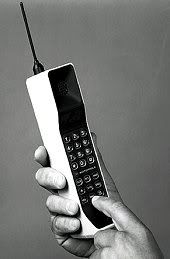
A slimmed-down version of the DynaTAC from the early 1990s
| cell phones on the internet
Cell phone providers began to carry the Internet on their cellular networks in 1996. To access Web content, phones were equipped with special programs known as mobile browsers. Some browsers could access regular websites, while others could only access specially-formatted websites written especially for mobile devices.
- regular websites: Depending on the browser, regular websites could be displayed in either text or full HTML format. The first cell phone to offer text-only web browsing was the Nokia Communicator 9000 in 1996. Full HTML browsing came along in 1997 on phones using the Hitchhiker mobile browser.
- mobile websites: Mobile sites are optimized for tiny screens and slow speeds. They made their debut in 1996 and are written in a special code to display content in a simplified format.
In the 1990s, most cell phone providers offered only an abbreviated version of the Internet. Mobile networks such as AT&T's Wireless PocketNet and Bell Atlantic's Cellscape formed partnerships with content providers and restricted their subscribers to a small group of participating sites. In 1999, most of the new web-enabled cell phones on the market accessed the Internet in this manner.
Cell phones didn't have wi-fi capability yet. They accessed the Internet through the service provider's regular cellular network.
1999: Web Phone, The Next Big Thing?
AT&T Wireless PocketNet
smartphones
PDAs are pocket-sized digital organizers. When the functions of a PDA are combined with those of a cell phone, you have the PDA phone. In addition to the phone, typical features include a calendar, address book, notepad, calculator and world clock. Internet access may or may not be included.
The first PDA phone was the IBM Simon Personal Communicator in 1993. The Simon didn't have Internet access, but it could retrieve e-mail by connecting to a paging service.
The first PDA phone to offer Internet access was also the first phone of any kind to offer it....the Nokia Communicator 9000 in 1996.
When Ericsson introduced their new PDA phone in 1997, they called it a smartphone, and a new term was born.
IBM Simon Personal Communicator
|
| 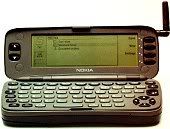
Nokia Communicator 9000, the first smartphone with Internet access
| other phones
In 1995, cordless phones were owned by 59 percent of the population, and answering machines were owned by 60 percent.

pagers
A pager is a small radio device that receives instant messages from a paging service. Early units simply beeped when a message came in, and the owner called the service to retrieve the message. In the 1990s, pagers could display a line of text or a phone number for the owner to call directly. Before cell phones became smaller and more affordable in the late 1990s, pagers enjoyed a brief period of popularity. Once used exclusively by doctors and other emergency personnel, their use by the general public tripled between 1990 and 1994.
Pagers
|
|
|
___________________________________
|
|
|
RetroLisa
| _________________________________________________________________ | __ | _______________________________ | _______ | Audio & Video

compact disc
The CD was introduced in 1982. By 1993, it was the #1 recording format, having surpassed vinyl LPs in 1988 and cassettes in 1993. By 1990, most record stores were selling their last remaining vinyl albums for $1 each to get rid of them.
The Sony MiniDisc was introduced in 1992. It was available in two formats: pre-recorded discs that functioned like a standard CD, and recordable discs.
burning a CD
The CD-R was introduced in 1990, and the CD-RW was introduced in 1997. These blank recordable CDs were originally used to store computer data and programs. A CD-R cannot be reused, while a CD-RW can be re-written up to 1,000 times.
The process of transferring data to a CD is known as writing or burning. Before the late 1990s, CD writers were extremely large and expensive. The technology became affordable for the average consumer in the late 1990s, and this inspired people to start using CD burners and software to create music CDs.

digital music
In the 1990s, a variety of programs were available that could extract audio tracks from a CD and store them on your computer. The files were encoded in several formats, including AIFF, WAV, WMA and MP3. There were also several computer media players that could play them, including Quicktime, Windows Media Player and Winamp.
In 1993, the introduction of the MP3 audio format began to change the way we listen to music. It was the most popular format for sharing music online, and a handful of pioneering websites arose that specialized in selling MP3 downloads.
The first portable MP3 players went on the market in 1998. These devices allowed you to transfer your digital music from a computer to a small portable player for use with headphones.
In 1999, the combination of high-speed Internet access and peer-to-peer file sharing software caused the number of music downloads to skyrocket. Buying and listening to music would never be the same again.
The First Portable MP3 Player
| | 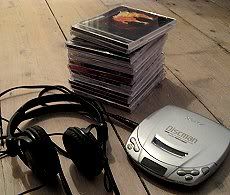
Sony Discman

|
video players
videocassette
In the 1990s, the VCR was still king. 88 percent of American households had a VCR in 1995.
People who were "video challenged" could use VCRPlus+ to program their VCRs to tape their favorite shows.
Many manufacturers also sold telecorders, which were small TV sets with VCRs built in.
laserdisc
Laserdiscs were introduced in 1978. Sales were slow during the early years, although serious movie collectors embraced the format's extra features and superior video quality right from the start. The discs and players were very expensive, and laserdisc titles were often hard to find.
Sales increased slightly in the 1990s when the machines became more affordable and the ability to play CDs was added. In 1995, digital surround sound made its home video debut on laserdisc. These factors coincided with the growth of the home theater industry, which made laserdisc players a more viable option for entertainment systems. Approximately 2 percent of American households owned a laserdisc player in the late 1990s. The advent of the DVD in 1997 made laserdiscs obsolete, and the last laserdisc players were produced in 2009.
DVD
DVDs were introduced in 1997. To make the transition to the new format easier, many early DVD players were part of laserdisc units, and were later combined with VCRs. 7 percent of households owned a DVD player in 1998.
Laserdisc Player Archive
VCRPlus+
Projection TV
home theater
In the old days, what passed for home theater was simply a TV and VCR, possibly hooked up to a hi-fi system. In the late 1980s, the advent of affordable big screen projection TVs and high quality stereo equipment resulted in more sophisticated home theater systems. The addition of digital surround sound in 1995 made the home cinema experience complete.
television
closed captioning
Beginning in 1993, all television sets with 13-inch screens or larger were required to have a built-in closed captioning decoder. Set-top decoders had been available since 1980.
digital TV
Prior to 1996, television signals were transmitted using analog technology. Digital broadcasting transmits digital signals and uses data compression to occupy far less bandwidth. Digital broadcasting was officially launched in 1998, and the first digital sets and set-top converter boxes went on the market in 1997.
high definition TV
A standard TV uses a resolution of 525 lines. A high definition TV is a digital TV with a resolution of 720 or 1,080 lines. This results in a sharper, clearer picture. The technology was developed in Japan, and the first HDTV sets in America went on sale in 1998.
camcorders
In 1990, a typical camcorder cost around $1,000. They were large, bulky contraptions that required a shoulder for support. During the 1990s, thanks to smaller videotape cartridges and digital technology, they became as small as regular cameras. The price came down drastically, too. They also began to feature LCD screens, which eliminated the need to look through the viewfinder with one eye.
| | 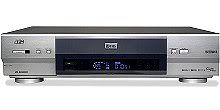
VCR
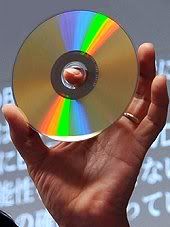
DVD
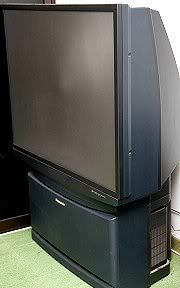
Rear projection TV
|
_________________________________________________
|
|
|
RetroLisa
| ___________________________________________________________________ | __ | _____________________________ | _______ | Computers
desktop
By the 1990s, personal computers had settled comfortably into two types: Macs and PCs. Popular PC manufacturers included Packard Bell, Compaq, IBM, Hewlett-Packard, NCR, and Toshiba. During this decade, the industry said farewell to Tandy and Commodore and welcomed Acer, eMachines, and Sony. In the late 1990s, companies like Dell and Gateway began to carve their niche in the built-to-order PC market.
Apple was at the threshold of a new era in the mid 1990s. Their popular Apple IIe model was discontinued in 1993 after ten years of production. The MacIntosh was still selling relatively well, but was being eclipsed by the increasing popularity of the Windows format. It was time to shake things up, and in 1998 they did just that by introducing the iMac. This computer had a revolutionary new look and an Internet-savvy name. From that point on, Apple would use the lower-case i on all of their Internet-connected innovations.
A typical desktop computer during this time cost between $1,000 and $2,000. In 1997, the Compaq Presario was the first computer to come in under $1,000. This launched a new category of relatively inexpensive computers known as Sub 1000 computers.
laptop
In the 1990s, laptop computers continued to increase in functionality and come down in price. New sizes were also available. A traditional laptop has a screen size of 14 inches or larger. Beginning in 1988, subnotebook computers were introduced with screen sizes ranging from 6 to 13 inches. The first ultra thin laptops were introduced in the late 1990s.
* Epson ActionNote
* MacIntosh PowerBook
* IBM ThinkPad
* Sony Vaio
* Toshiba Libretto
* HP Pavilion
* NEC Versa
* Toshiba Satellite
* Hitachi VisionBook
* Compaq LTE
* Toshiba Portege
* Compaq Presario
* HP OmniBook
| | 
iMac
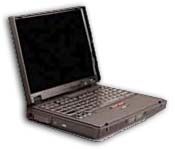
|
| ________________________________________________ | ___ | ______________________________________________ | ________ | mobile
In the 1990s, mobile computers fell into four categories:

* Pocket computers resembled oversized calculators. They were introduced in the early 1980s and could be programmed to run basic software. The category became obsolete in the mid 1990s with the advent of digital organizers and palm-sized PCs.
----* Sharp PC Pocket Computer

* Palmtop computers were miniature laptops with scaled-down operating systems and limited functionality. The first models went on the market in 1989.
----* Atari Portfolio
----* Poqet PC
----* Philips Velo
----* HP Jornada
----* Sharp Mobilon
----* HP OmniGo
----* NEC MobilePro
----* HP LX Palmtop
| |

* Tablet computers were handheld devices with touchscreen technology. They used a stylus for input and came in two varieties: slates and convertibles. Slate tablets were flat one-piece units with virtual onscreen keyboards. Convertible tablets were traditional laptops that functioned like tablets when the keyboard was folded out of the way.
In the 1990s, tablets were generally called pads or pentops. Touchscreen technology was known as pen computing.
----* GRiDPad
----* IBM ThinkPad
----* Momenta Pentop
----* Compaq Concerto
----* EO Personal Communicator
----* Dauphin 5000 Series Pentop

* Palm-sized PCs were small computers that could fit in the palm of your hand. They ran a special version of Windows designed for small devices. This made them computers and not merely organizers.
----* Everex Freestyle
----* Casio Cassiopeia
----* HP Jornada
----* Philips Nino
|
| ___________________________________________________________________ | __ | _____________________________ | _______ | organizers
Simple pocket-sized computers were introduced in the 1980s. In the 1990s, their functions were streamlined and they became known as digital organizers. In 1992, the term PDA (personal digital assistant) was coined by the CEO of Apple to refer to their new line of Apple Newton organizers.
PDAs typically offered calendars, address books, to-do lists, calculators, notepads, and world clocks. Most models used a stylus and handwriting recognition program for input.
In the 1990s, some models could retrieve e-mail by connecting to a paging service. Beginning in 1995, many units could also browse the web by connecting to a desktop computer, external modem, or web-enabled cell phone.
The first PDA to access the Internet with an internal wireless connection was the Palm VII in 1999. This wasn't true web browsing, however. A paid account at the Palm website provided the user with access to a mobile paging network, where a small number of participating websites offered limited services through the use of web clipping applications.
* Palm Pilot
* Palm VII
* Apple Newton MessagePad
* Sharp ExpertPad
* Motorola Marco
* Sony Magic Link
* DataRover 840
* Sharp Pocket Locker
* Tandy Zoomer
* Digital Ocean Seahorse
* Casio Digital Diary
* Sharp Wizard
* Motorola Envoy
* Amstrad PenPad
* Psion Series
| | 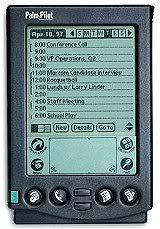
The Palm Pilot was introduced in 1996. Its size, price, and ease of use made it the most popular PDA of the decade.
|

features & formats
In 1993, the Intel Pentium Processor made increased computer speeds possible. In the late 1990s, floppy disks were on their way out, as more computer users stored their data on CDs and Zip disks. In 1998, the Apple iMac was the first computer designed without a floppy disk drive.
Many features that are commonplace today were first introduced in the 1990s. They include the USB connection (1996), TrueType fonts (1991), true color displays (1990), and higher screen resolutions. The 1990s also gave us the JPG and PNG image formats.
In the early 1990s, it became possible to store high-quality audio files on your computer. The WAV format was introduced as part of the Windows 3.1 package in 1992, and the MP3 format was introduced in 1993.

peripherals
Digital camera technology was developed for the NASA space program in the 1960s. During the 1970s and 1980s, a few very expensive digital cameras were available for professional use, and were designed to be connected to a TV for slide shows. In 1994, the Apple QuickTake 100 was the first affordable digital camera intended for use with computers.
Webcams, laser-jet printers, and scanners also came into common usage in the 1990s.
| |
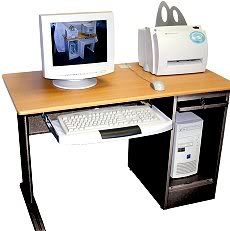 |
_________________________________
|
|
|
RetroLisa
| ___________________________________________________ | __ | _____________________________ | _______________________ | Consumer Products
food & drink
- Baked Lay's potato chips
- Mountain Dew
- bottled water
- Zima
- gourmet coffee
- veggieburgers
- beer from microbreweries
- Snapple
- stuffed-crust pizza
- dolphin-safe tuna
health & beauty
Glitter was everywhere....in soap, in body spray and in Lip Smackers. If you enjoyed ripping your leg hairs out by the root, then Epilady was just what you needed.
- body glitter
- Epilady
- glitter soap
- nylon mesh shower sponges
- Bonne Bell Lip Smackers
- Hairdini
- Topsy-Tail
- hair scrunchies
- shower gel
- Salon Selectives
- Cucumber Melon bath products
| | 



|
__________________________________________
|
|
|
RetroLisa
| ___________________________________________________________________ | __ | _____________________________ | _______ | Home Shopping

as seen on TV: home shopping networks
In 1977, a Florida radio station held an on-air auction of merchandise they received from an advertiser in lieu of payment. The concept became a regular feature on the station, and when it moved to cable TV in 1981, the Home Shopping Network (HSN) was born. The channel went nationwide in 1985.
The QVC shopping channel was launched in 1986. In November of that year, it debuted on 58 cable systems in 20 states. In the 1990s, viewers enjoyed taking advantage of Today's Special Value and dishing the dirt with popular hostess Kathy Levine.

as seen on TV: infomercials
The half-hour infomercial was born in 1984, when the government lifted the regulations limiting the length of TV commercials. They hit their stride in the early 1990s and have been entertaining insomniacs ever since.
home shopping from your computer
The auction site known as eBay got its start in 1995 as AuctionWeb. It was originally just a small part of the founder's website, which was named after his consulting firm, Echo Bay Technology Group. In 1997, the auction page took over the entire website, where it became the eBay site that we know today.
| | 
Hair loss getting you down? With GLH (Great Looking Hair), hair replacement is just a spray can away!
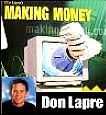
|
_______________________________
|
|
|
RetroLisa
| _________________________________________________ | ___ | _________________________________________________ | ____ | Advertising
Bugle Boy jeans:
"Excuse me, are those Bugle Boy jeans you're wearing?"
Mentos breath mints:
"Mentos, the freshmaker!"

Hair Club For Men:
"I'm not only the Hair Club president, I'm also a client"

Taco Bell:
"Yo quiero Taco Bell!"
ICS correspondence schools:
"At ICS, more than ten million men and women have trained for new careers without setting foot inside a classroom."
Motel 6:
"I'm Tom Bodet, and we'll leave the light on for ya"
Budweiser:
"I love you, man!"
Budweiser:
"Bud-Weis-Er"
The Budweiser Frogs
| |
|
__________________________________________
|
|
|
